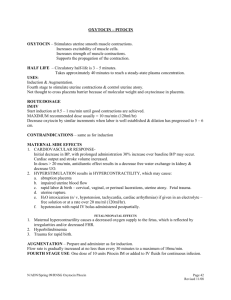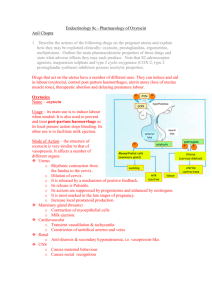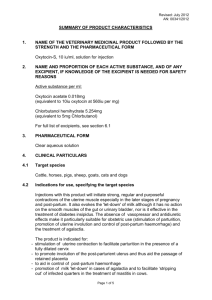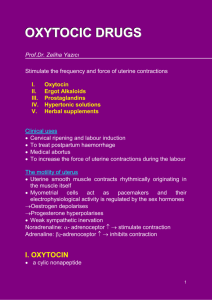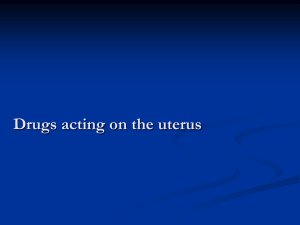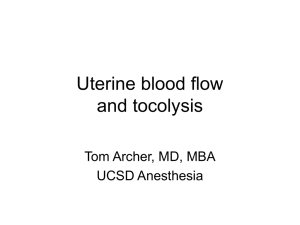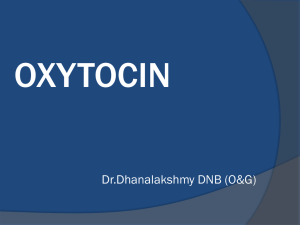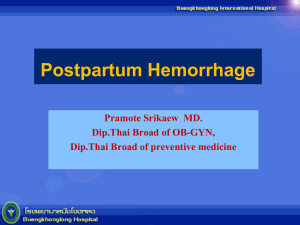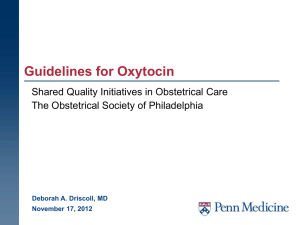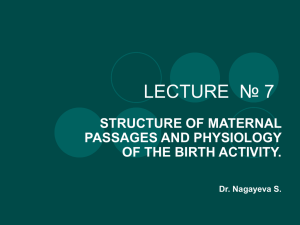Lecture 2- oxytocics& tocolytics(2nd yr block).
advertisement
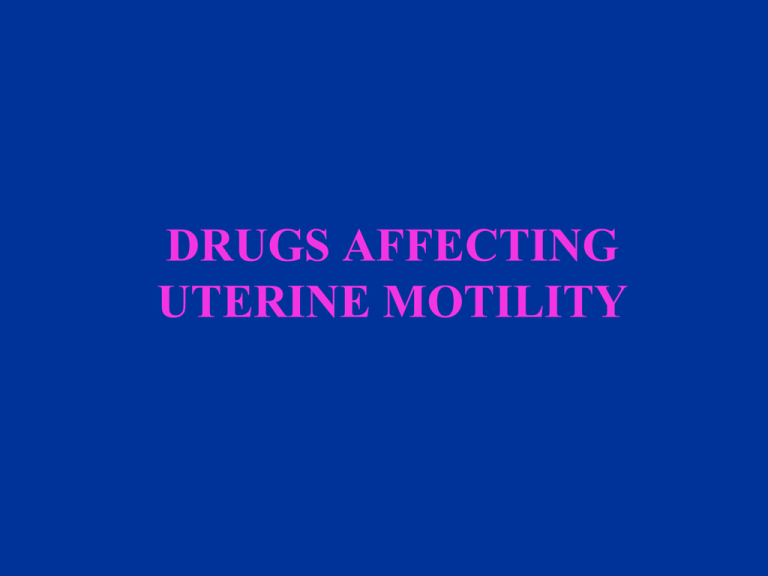
DRUGS AFFECTING UTERINE MOTILITY Objectives At the end of the lectures, students should be able to know and understand the: 1.Drugs used to induce & augment labor. 2.Drugs used to control post partum hemorrhage. 3.Drugs used to induce pathological abortion. 4.Drugs used to arrest premature labor. 5.The mechanism of action and adverse effects of each drug. Drugs affecting uterine contractility Oxytocic drug : » Drugs stimulate uterine smooth muscles during • pregnancy , produce contraction that promotes rapid labor Tocolytics: • Drugs relax uterine smooth muscles • OXYTOCIC Drugs Oxytocin ( posterior pituitary hormone) • Ergot alkaloids • Ergotamine • Ergonovine • Methyl ergometrine • Oxytocic Agents ( cont.) Prostaglandines • PGE2 • PGF2α • Misoprostol • OXYTOCIN R (Syntocinon ) Synthesis • Is a posterior pituitary hormone • Oxytocin secretion occurs by sensory stimulation from cervix ,vagina , and from suckling at breast. Pharmacokinetics of oxytocin Destroyed in GIT • Not effective orally • Given IV or nasal spray ( in cases of impaired milk ejection) • Not bound to plasma proteins • Eliminated by liver & kidneys • Half life = 5 minutes Pharmacodynamics of oxytocin • • Mechanism of action Acts through GPCR activation of phospholipase C production of IP3 mobilization of calcium from its stores (SR) • Also, activates voltage sensitive calcium channels causing an increase in cytoplasmic calcium level that stimulates uterine contraction . Pharmacological actions of oxytocin Uterus • Small doses stimulates both the frequency and force of uterine contractility particularly of the fundus segment of the uterus. • These contractions resemble the normal physiological contractions of uterus (contractions followed by relaxation) • Large doses causes sustained contractions • Immature uterus is resistant to oxytocin. • Contract uterine smooth muscle only at term • Sensitivity increases to 8 fold in last 9 weeks and 30 times in early labor. • Clinically oxytocin is given only when uterine cervix is soft and dilated. Cont. Mammary glands • • Stimulate myoepithelial cells surrounding mammary • alveoli produce milk production Without oxytocin induced contraction lactation can not • occur. Therapeutic Uses of Oxytocin 1. Facilitation of labor at term IV-infusion (Reinforcement of labor) 2- Induction of labor for conditions requiring early vaginal delivery ( I.V infusion ) e.g. Placental insufficiency ( mild preeclampsia, maternal diabetes) Post maturity Premature rupture membranes Uterine inertia Therapeutic Uses of Oxytocin (continue) 3- Post partum uterine hemorrhage after vaginal or cesarean delivery (I.M) (ergometrine is often used) 4- Impaired milk ejection One puff in each nostril 2-3 min before nursing 5- Incomplete abortion Adverse effects Fetal Distress, death Maternal Uterine rupture Fluid retention, water intoxication Hyponatremia, heart failure Seizures Death Bolus injection can produce hypotension, so used as infusion at a controlled rate Contraindications a) Hypersensitivity b) Prematurity c) Abnormal fetal position d) Evidence of fetal distress e) Cephalopelvic disproportion Precautions a) Multiple pregnancy b) Previous c- section c) Hypertension Ergot Alkaloids Natural • Ergonovine • Synthetic • Methyl ergometrine • Methyl ergonovine • Effects on the Uterus • Alkaloid derivatives induce TETANIC CONTRACTION of uterus without relaxation in between(not like normal physiological contractions) • It causes contractions of uterus as a whole i.e. fundus and cervix(tend to compress rather than to expel the fetus) Difference between oxytocin & ergots?? Ergot alkaloids( pharmacokinetics) • Absorbed orally from GIT (tablets) • Usually given I.M • Extensively metabolized in liver. • 90% of metabolites are excreted in bile Clinical uses • Post partum hemorrhage o Hastens involution of the uterus Preparations Syntometrine(ergometrine 0.5 mg + oxytocin 5.0 I.U), I.M. Side effects Nausea, vomiting, diarrhea Hypertension Vasoconstriction of peripheral blood vessels ( toes & fingers) Gangrene • Contraindications: Induction of labor 1st and 2nd stage of labor vascular disease Severe hepatic and renal impairment Severe hypertension Prostaglandins Dinoprostone ( synthetic PGE2) • Given intravaginally as a gel or tablet • Given extra-amniotically as a solution • 1st metabolism in lung ( 95%) • Metabolized in local tissues • Metabolites excreted in urine • Some absorption directly through cervix & lymphatics into maternal circulation Half-life 2.5- 5 min • • Effects of dinoprostone Stimulation of G protein coupled PGE2 receptors contraction of myometrium Ripening of cervix due to direct effect on cervical collagenase resulting in softening Has natriuretic effect Superior to oxytocin for women with pre-eclampsia , as no fluid retention Therapeutic uses of dinoprostone Facilitation of labor at term • Induction of labor • Medical Abortifacient • Used as vaginal suppositories alone or with oral • misoprostol Adverse effects Nausea, vomiting, diarrhea • Incomplete abortion • Increase blood loss • Carboprost: 15 methyl PGF2α Analog Therapeutic uses • Induction of labor • • To control PPH IMI • • For 2nd trimester abortion , single intra-amniotic injection • Adverse effects Vomiting, diarrhea • Transient rise of temperature • Bronchoconstriction • Fetal toxicity uncommon • Misoprostol ( synthetic PGE1) Given intravaginally as a gel or tablets • • Contraindications of prostaglandins: a) Mechanical obstruction of delivery b) Fetal distress c) Predisposition to uterine rupture • Precautions: a) Asthma b) Multiple pregnancy c) Glaucoma d) Uterine rupture Difference B/w Oxytocin and Prostaglandins Character Oxytocin Prostaglandins Contraction Only at term Contraction through out pregnancy Cervix Does not soften the cervix soften the cervix Difference (cont’d) Character Oxytocin Prostaglandins Duration of action uses Shorter Longer Induce and augment labor and post partum hemorrhage Induce abortion in 2nd trimester of pregnancy. Used as vaginal suppository for induction of labor Difference b/w Oxytocin and Ergometrine Character Oxytocin Contractions Resembles normal physiological contractions Uses Onset and Duration To induce &augment labor. *Post partum hemorrhage Rapid onset Shorter duration of action Ergometrine Tetanic contraction ; doesn't resemble normal physiological contractions Only in postpartum hemorrhage Moderate onset Long duration of action TOCOLYTIC DRUGS Drugs relax uterine muscles & inhibit uterine contractions Tocolytic Drugs Uses To arrest premature labor Delay delivery for 48 hrs , this time can be used to administer glucocorticoids ( Injection betamethasone) to mother for maturation of the fetal lung Classification of tocolytic drugs B2 selective stimulants • ( Ritodrine, salbutamol) • Oxytocic Antagonist • Atosiban • • Other dugs • Magnesium sulphate • Calcium channel blockers ( nifedipine) • COX inhibitors ( indomethacin) • Ritodrine (β- adrenoceptor agonist) • Mechanism of action Bind to β-adrenoceptors , activate Adenylate cyclase , increase in the level of cAMP reducing intracellular calcium level. • Side effects: • Anxiety, Restlessness, Headache • Pulmonary edema • Flushing • Sweating • Tachycardia (high dose) • Hypotension • Hyperglycemia ( Atosiban ) Oxytocic Antagonist Antagonizes the effects of oxytocin at its receptors • Used as tocolytic in premature labor • Given by IV infusion for 48 hrs • CALCIUM CHANNEL BLOCKERS (Nifedipine) • Causes relaxation of myometrium • Markedly inhibits the amplitude of spontaneous and oxytocin-induced contractions • Adverse effects • Headache, dizziness • • • • Hypotension Flushing Ankle edema Tachycardia COX inhibitors • The depletion of prostaglandins prevents stimulation of uterus NSAID,s e.g. Indomethacin Aspirin Ibuprofen Adverse effects ulceration • premature closure of ductus arterious.
